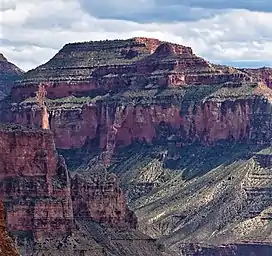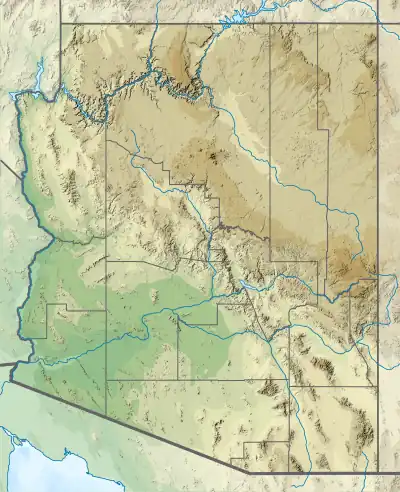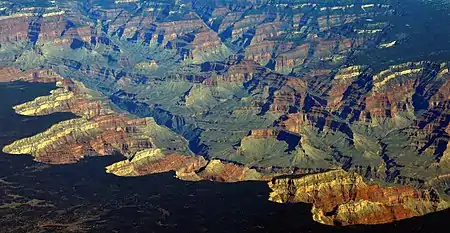Evans Butte (Grand Canyon)
Evans Butte is a 6,379-foot-elevation (1,944-meter) summit located in the Grand Canyon, in Coconino County of northern Arizona, US.[2] It is situated at the north end of Sagittarius Ridge, three miles south-southwest of King Arthur Castle, and two miles southeast of Dox Castle. Topographic relief is significant as it rises over 4,100 feet (1,200 meters) above the Colorado River in 2.5 miles (4.0 km), and the north aspect rises 2,700 feet above Flint Creek in one mile. According to the Köppen climate classification system, Evans Butte is located in a cold semi-arid climate zone, with precipitation runoff draining west to the Colorado River via Shinumo Creek, Hotauta Canyon, and Monadnock Amphitheater.[4] The butte is composed of Pennsylvanian-Permian Supai Group overlaying the cliff-forming Mississippian Redwall Limestone, and Cambrian Tonto Group.[5] Evans Butte was climbed solo by Harvey Butchart on October 11, 1976, thereby making it the 76th of the 83 summits which he climbed in the Grand Canyon.[3]
| Evans Butte | |
|---|---|
 Northwest aspect | |
| Highest point | |
| Elevation | 6,379 ft (1,944 m)[1] |
| Prominence | 599 ft (183 m)[1] |
| Parent peak | Guinevere Castle (7,281 ft)[1] |
| Isolation | 2.54 mi (4.09 km)[1] |
| Coordinates | 36°13′47″N 112°17′29″W[2] |
| Geography | |
 Evans Butte Location in Arizona  Evans Butte Evans Butte (the United States) | |
| Location | Grand Canyon National Park Coconino County, Arizona, US |
| Parent range | Kaibab Plateau Colorado Plateau |
| Topo map | USGS Havasupai Point |
| Geology | |
| Type of rock | sandstone. limestone, shale |
| Climbing | |
| First ascent | 1963 |
| Easiest route | scrambling[3] |
Richard Tranter Evans

Evans Butte was named after Richard Tranter Evans (1881–1966), U.S. Geological Survey senior topographic engineer from 1899 to 1951, who surveyed and mapped this area of the Grand Canyon in 1904.[2] In the course of his mapping, this cartographer bestowed several nearby geographical features with an Arthurian legend naming theme, e.g. King Arthur Castle, Guinevere Castle, Elaine Castle, Merlin Abyss, Gawain Abyss, Bedivere Point, Lancelot Point, and Galahad Point.[6] Richard T. Evans was a protégé of François E. Matthes. Evans completed 107 topographic mapping assignments, which included several national park areas.[2] He drew the first topographic maps of Pikes Peak, the Grand Canyon, and Salt Lake City. He was the acting superintendent of Zion National Park from 1925 to 1926, and superintendent of Hawaii National Park from 1927 to 1928.[2] He was a member of the Cosmos Club, The Explorers Club, American Society of Civil Engineers, and a Member Emeritus of American Society for Photogrammetry.[7] This geographical feature's name was officially adopted in 1969 by the U.S. Board on Geographic Names.[2]
See also

References
- "Evans Butte – 6,379' AZ". Lists of John. Retrieved 2021-02-23.
- "Evans Butte". Geographic Names Information System. United States Geological Survey, United States Department of the Interior. Retrieved 2021-02-23.
- Harvey Butchart’s Hiking Log – Detailed Hiking Log (October 7, 1976 – February 26, 1978)
- Peel, M. C.; Finlayson, B. L.; McMahon, T. A. (2007). "Updated world map of the Köppen−Geiger climate classification". Hydrol. Earth Syst. Sci. 11. ISSN 1027-5606.
- N.H. Darton, Story of the Grand Canyon of Arizona, 1917.
- Gregory McNamee, Grand Canyon Place Names, 1997, Mountaineers Publisher, ISBN 9780898865332, page 53.
- Evans, R.T., and Frye, H.M., 2009, History of the topographic branch (division): U.S. Geological Survey Circular 1341, ISBN 9781411326125
External links
- Weather forecast: National Weather Service
- History of the Topographic Branch Richard T. Evans author
- Matthes – Evans topographic map of Grand Canyon National Park: Library of Congress
- Richard Tranter Evans photo: USGS
- Evans Butte and Guinevere Castle photo by Harvey Butchart